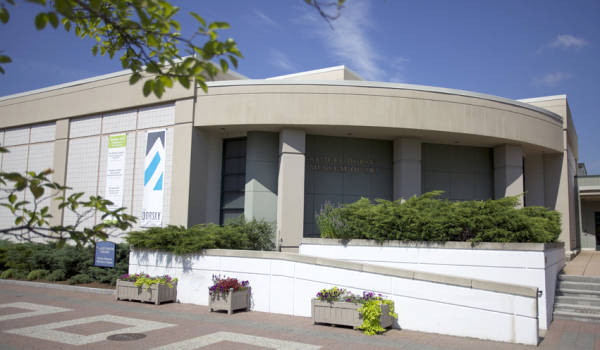
A small, pleasantly-lit room in the Samuel Dorsky Museum of Art welcomed passionate alumni brimming with stories to share of the late Hugo Munsterberg, Professor Emeritus of Art History at the SUNY New Paltz from 1958-1979.
On Oct. 15 at 3 p.m., Associate Professor of the Department of Art History Elizabeth Brotherton facilitated a discussion for SUNY New Paltz alumni proceeding the gallery talk, “All Excess Stripped Away: Donations to the Dorsky Museum by Hugo Munsterberg.”
The intimate event was held in the seminar room of the Dorsky, where approximately 20 alumni gathered for some well-described nostalgia.
Brotherton began the discussion by introducing a subject many art historians debate upon: What is a better way of viewing art: through a generalist or formalist lens?
A generalist will mainly focus on the aesthetic or emotion the piece of artwork conveys, whereas a formalist will attempt to understand the piece by considering background such as the artists’ political views, the political climate of the time it was created, etc.
Munsterberg was described as more of generalist with an ardor for Asian, African and other examples of non-western art. He was a quirky professor who “used to stand in front of the classroom with his eyes closed for a bit in the beginning of class,” one alumni recalled.
The beloved professor was born in Berlin in 1916 to a German father and an American mother. Munsterberg was raised with dual citizenship in America and Germany. In 1935, he left for America.
He earned both his B.A. and P.h.D. at Harvard University in 1938 and 1942, respectively. Munsterberg wrote his dissertation on early Chinese Buddhist bronzes.
When Munsterberg joined the SUNY New Paltz Art Division in 1958, he was the first art historian to be hired by the college and later the first chair of its art history department. According to Brotherton, Munsterberg’s influence inspired other art history scholars to teach at SUNY New Paltz.
Alumni present who took his courses described him as a very human professor, who would share with them “earthy” stories: Munsterberg also had a reputation as a flirt.
Dr. Sadie Penzato, class of ’66, said she was an older student when she had Munsterberg as a professor. Penzato recounted a moment where she walked into his office to find him speaking with two beautiful 18-year-old girls who were batting their eye lashes at him, and “he was loving it.”
“After they left the room I said to him, ‘Aren’t they beautiful?’’ Penzato said. “He responded, ‘My dear, who isn’t beautiful at 18!’”
Thomas Pike, class of ’60, laughed when he recalled Munsterberg’s immense passion when describing art, and his regular use of the word “voluptuous.”
“He could always evoke an emotional response to art from us, even if we didn’t acknowledge it at first,” Pike said.
Distinguished Emeritus and Department of Geography Professor Ronald G. Knapp was present at the discussion, and spoke of Munsterberg as his colleague. Knapp was 24 years younger than Munsterberg when they both worked at SUNY New Paltz.
Knapp shared that although Munsterberg had a great love of Asian art, he had never been to any part of Asia until he began working at the college. Knapp and Munsterberg both went on an art research trip to various parts of China with a group of other art historians.
“The man terrified me,” Knapp said. “As soon as he started talking to me he was friendly, but I would always stammer in my responses. Over time, I got to know him well, and we established a mutual respect.”
Knapp smiled while recalling Munsterberg’s dry, blunt nature when critiquing someone’s purchase of artwork.
“He would outright tell the person, ‘You don’t have taste!’” Knapp said. “We would get into heated debates. He was a dragon, and I was a dragon.”
